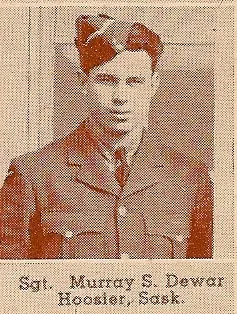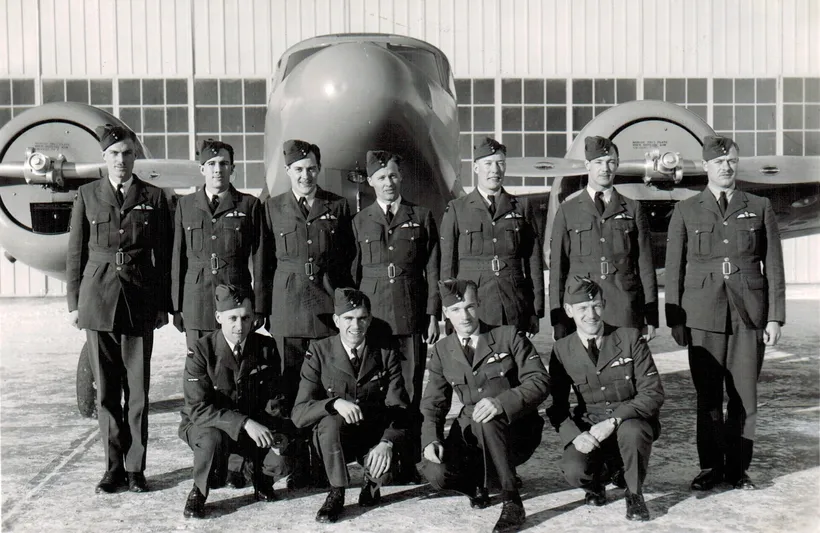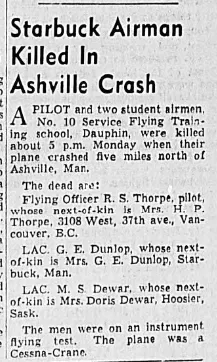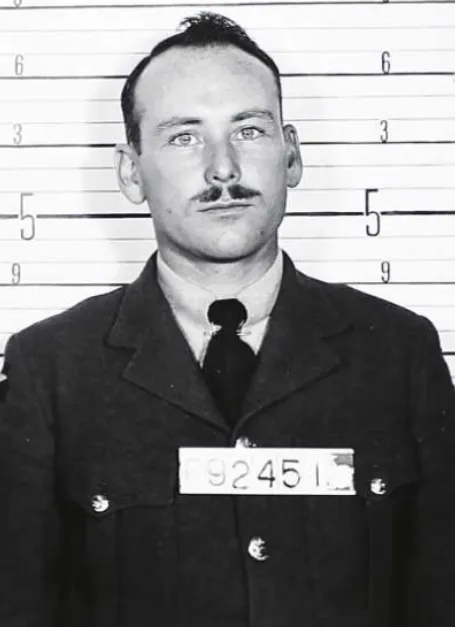Dewar, Murray Stewart (Leading Aircraftman)
Killed in Flying Accident 1943-January-11


Birth Date: 1920-July-02
Born: Dodsland, Saskatchewan
Parents: James Stewart Dewar & Ruby Doris Dewar
Spouse:
Home: Hoosier, Saskatchewan (parents)
Enlistment: Saskatoon, Saskatchewan
Enlistment Date: 1941-October-04
Service
RCAF
Unit
10 SFTS- Service Flying Training School
Base
RCAF Stn. Dauphin, Manitoba
Rank
Leading Aircraftman
Position
Pilot
Service Numbers
R/128434
Crew or Other Personnel
Crane 7897
Crane serial: 7897

Canadian Warplane Heritage Museum
The Cessna T-50 Crane was the RCAF version of the Cessna AT-17 Bobcat, a twin-engined advanced trainer designed and made in the USA during the Second World War. It served to bridge the gap between single-engined trainers and twin-engined combat aircraft.
First flown in 1939, the American-built Cessna Crane was developed as a five-seat, light transport civilian aircraft. It was originally intended to serve only a minor role within the BCATP (an initial 180 were ordered in 1940) until the Canadian-built Avro Ansons became available in greater numbers. This was the first large order that Cessna had received for one of its products. Eventually, more than 5,400 Cranes would be produced, of which 826 saw service with the RCAF. Cessna Cranes were used primarily to teach future bomber pilots, after they had received their initial training, to fly multi-engined aircraft at Service Flying Training Schools in western Canada.
Powered by 245-horsepower Jacobs R-755-9 radial engines, Cessna Cranes featured wooden wings and tail married to a fuselage constructed of welded steel tubing. Most of the aircraft was fabric-covered. It was cheap, reliable and relatively easy to fly, with a top speed of 315 kilometres (195 miles) per hour.
The Crane provided twin-engined complexity with economy of operation and went on to become one of the most important aircraft used by the BCATP. Cranes continued to serve with the RCAF until 1947, after which many were purchased by private individuals and companies.
Nicknamed the Bamboo Bomber because of its largely wood construction, the Crane had a reputation as a stable and reliable aircraft. Although not an ideal training aircraft because of its poor single-engined performance and load-carrying capability, it performed its duties satisfactorily and helped train several thousand bomber pilots. Bomber Command Museum of Canada
Aircraft Images
Crane 7897
Crane Mk. I 7897
First used by No. 12 Service Flying Training School at Brandon, Manitoba. Category C14 damage at the Brandon aerodrome at 15:45 on 16 July 1941. Category C1 damage at Dauphin at 08:30 on 24 December 1941, reported by No. 10 Service Flying Training School. Scheduled for overhaul at Prairie Airways from 5 October 1942, but this was cancelled. Written off at No. 10 SFTS following a Category B crash.1941-July-16 Accident: 12 Service Flying Training School Loc: Aerodrome Names: Wright
1941-08-21 Taken on Strength No. 2 Training Command 2019-08-20
1941-December-24 Accident: 10 Service Flying Training School Loc: Dauphin Names: Dean | Rees
1943-January-11 Accident: 10 Service Flying Training School Loc: Ashville Names: Dewar | Dunlop | Thorpe
1943-01-28 Struck off Strength Struck off, reduced to spares and produce 2019-08-20
Unit Desciption
10 SFTS (10 Service Flying Training School)
Graduates of the EFTS "learn-to-fly" program went on a Service Flying Training School (SFTS) for 16 weeks. For the first 8 weeks the trainee was part of an intermediate training squadron; for the next 6 weeks an advanced training squadron and for the final 2 weeks training was conducted at a Bombing & Gunnery School. The Service schools were military establishments run by the RCAF or the RAF.
There were two different types of Service Flying Training Schools. Trainees in the fighter pilot stream went to an SFTS like No. 14 Aylmer, where they trained in the North American Harvard or North American Yale. Trainees in the bomber, coastal or transport pilot stream went to an SFTS like No. 5 Brantford where they learned multi-engine technique in an Airspeed Oxford, Avro Anson or Cessna Crane.

For More Information on RCAF Station Dauphin see here
RCAF.Info - RCAF Station Dauphin Manitoba
RCAF.Info - Relief Landing Field North Junction MB
RCAF.Info - Relief Landing Field Valley River MB
![]() Manitoba Historical Society - 10 SFTS Dauphin
Manitoba Historical Society - 10 SFTS Dauphin
![]() Manitoba Historical Society - North Junction Relief Landing Field
Manitoba Historical Society - North Junction Relief Landing Field

